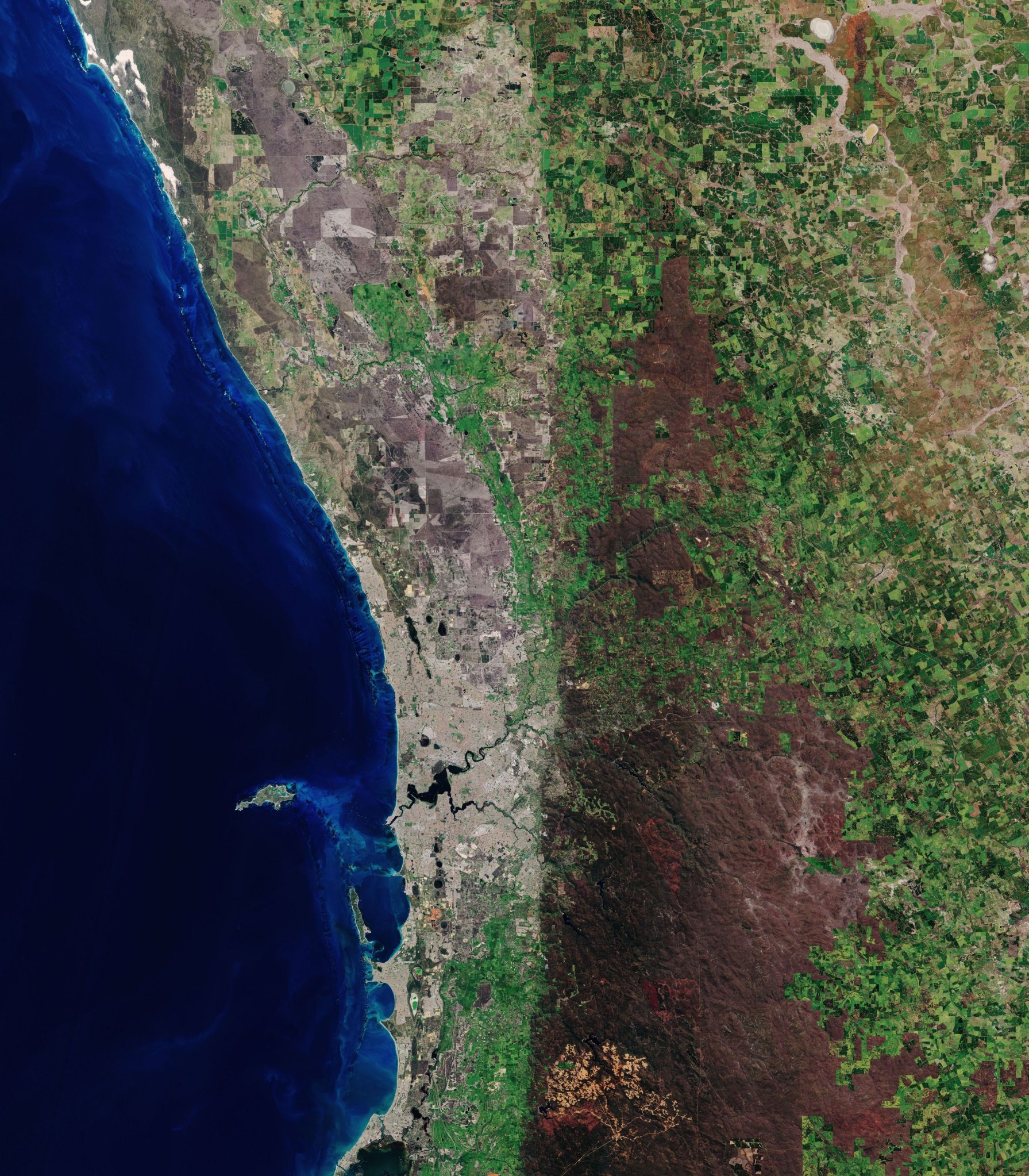Perth, la capitale e la più grande città dell’Australia occidentale, è mostrata in questa immagine in colori reali acquisita dalla missione Copernicus Sentinel-2.
L’area metropolitana di Perth si trova nella divisione sud ovest dell’Australia Occidentale, tra l’Oceano Indiano ed una bassa scarpata costiera nota con il nome di Darling Range. L’area si estende per circa 125 km lungo la costa, da Two Rocks a nord fino a Singleton a sud.
Il centrale quartiere degli affari e le periferie di Perth – la quarta città più popolosa d’Australia – sorgono sulle sponde del fiume Swan.
Prima della colonizzazione europea l’area è stata abitata per oltre 40 000 anni dalla popolazione dei Whadjuk Noongar. L’area dove attualmente si trova Perth fu battezzata ‘Boorloo’ dagli Aborigeni del luogo ai tempi del loro primo contatto con gli europei nel 1827.
Perth è una delle città più isolate della Terra, con il centro urbano a lei più vicino – Brisbane – situato a circa 2000 km di distanza. Perth risulta più vicina a Bali, in Indonesia, rispetto alla capitale dell’Australia – Canberra. A dispetto del suo isolamento, Perth è una delle città australiane con il più elevato tasso di crescita. Il suo aeroporto è visibile appena a sud del fiume Swan.
L’isola di Rottnest, chiamata anche Wadjemup dalla popolazione Noongar, si trova 19 km al largo della costa di Perth. Questa isole sabbiosa di 19 kmq è nota per la sua popolazione di quokkas, una delle specie più piccole di wallaby presenti in Australia. Si possono osservare diversi traghetti in viaggio da e per sia l’isola di Rottnest sia il porto di Freemantle, il più grande e trafficato porto di carico merci dell’Australia occidentale.
La caratteristica più impressionante di questa immagine della settimana è la differenza che si può osservare tra i territori boscosi (visibili di colore marrone scuro) e gli appezzamenti di terreno coltivato (visibili di colore verde). Alcuni dei territori boscosi qui presenti includono il John Forrest National Park e le foreste demaniali di Mundaring, Jarrahdale e Youraling.
L’intricata trama visibile in fondo all’immagine rappresenta la miniera di bauxite di Huntly, la seconda miniera di bauxite più grande al mondo. L’Australia è il maggior produttore mondiale di bauxite, un materiale grezzo utilizzato primariamente nella produzione dell’alluminio.
L’immagine include anche la località dove si trova la stazione di terra ‘deep space’ dell’ESA a New Norcia, a circa 120 km a nord-est di Perth. La stazione fornisce supporto a missioni quali ExoMars/TGO, BepiColombo e Solar Orbiter. Per questo sito è stata pianificata una nuova antenna con un disco di 35m di diametro.
La missione Copernicus Sentinel-2 è progettata per fornire immagini che possono essere impiegate per distinguere differenti tipi di coltivazioni, ma anche per ottenere informazioni su numerosi indici vegetali, tra cui l’area fogliare, la clorofilla fogliare e l’acqua fogliare, tutti essenziali per monitorare accuratamente la crescita delle piante.
Scarica immagine MediumRes (75,57 MB - .JPG)
Scarica immagine HighRes (250,59 MB - .TIF)
---
Perth, Australia
Perth, Western Australia’s capital and largest city, is featured in this true-colour image captured by the Copernicus Sentinel-2 mission.
The metropolitan area of Perth is located in the South West Division of Western Australia, between the Indian Ocean and a low coastal escarpment known as the Darling Range. The metropolitan area stretches around 125 km along the coast, from Two Rocks in the north, to Singleton in the south.
The central business district and suburbs of Perth, Australia’s fourth-most populous city, are situated on the banks of the Swan River.
Before European colonisation, the area had been inhabited by the Whadjuk Noongar people for over 40 000 years. The area where Perth now stands was called Boorloo by the Aboriginals living there at the time of their first contact with Europeans in 1827.
Perth is one of the most isolated cities on Earth, with its nearest city, Brisbane, located around 2000 km away. Perth is closer to Bali in Indonesia than Australia’s capital, Canberra. Despite its isolation, Perth is one of the fastest-growing cities of Australia. Its airport is visible just south of Swan River.
Rottnest Island, known as Wadjemup to the Noongar people, is located 19 km off the coast of Perth. This 19 sq km, sandy island is known for its population of quokkas, one of the smallest wallaby species in Australia. Several ferries can be seen journeying to and from Rottnest Island and Fremantle Harbour, Western Australia’s largest and busiest general cargo port.
The most striking feature in this week’s image is the difference between forested land (visible in dark brown) and agricultural plots and crops (visible in green) in the image. Some of the forested land pictured here includes John Forrest National Park and the Mundaring, Jarrahdale and Youraling State Forests.
The intricate pattern visible in the bottom of the image is the Huntly Bauxite Mine, the world’s second largest bauxite mine. Australia is the world’s largest producer of bauxite – a raw material used primarily in the production of aluminium.
The image also includes the location of ESA's deep-space ground station at New Norcia, about 120 km northeast of Perth. The station supports missions like ExoMars/TGO, BepiColombo and Solar Orbiter, and a new 35 m-diameter dish antenna is planned for the site.
The Copernicus Sentinel-2 mission is designed to provide images that can be used to distinguish between different crop types as well as data on numerous plant indices, such as leaf area, leaf chlorophyll and leaf water – all essential to monitor plant growth accurately.
(Fonte: ESA - Image of the week: "Perth, Australia". Traduzione: Gianluca Pititto)
Copia qui lo "short link" a questo articolo
www.geoforall.it/{sh404sef_shurl}




